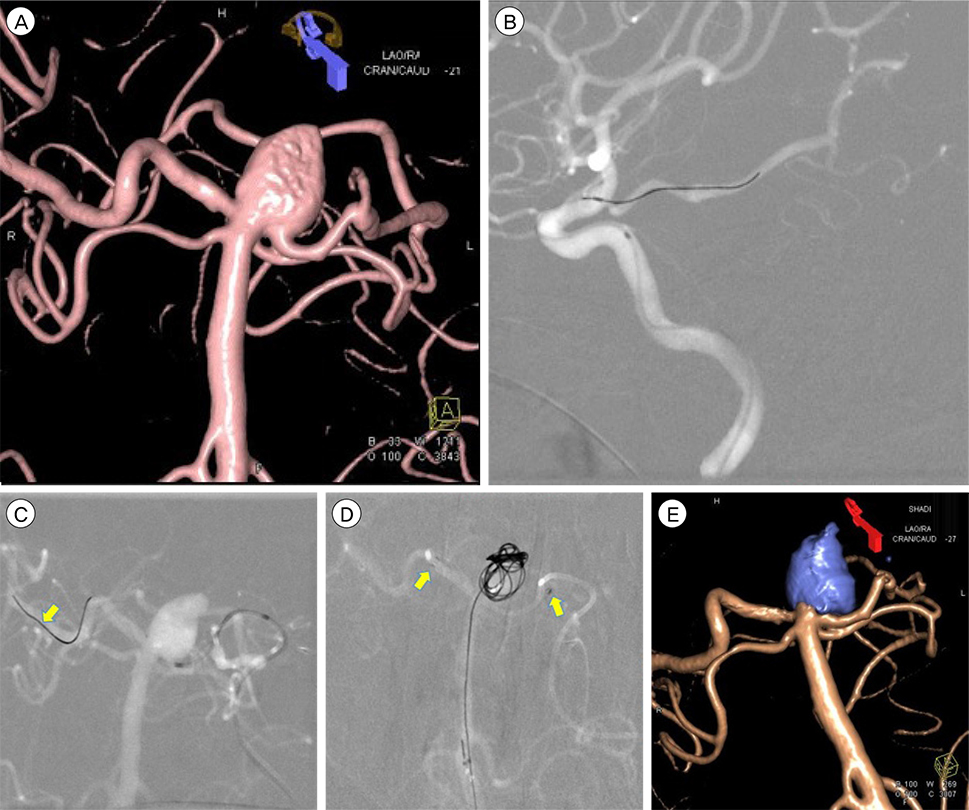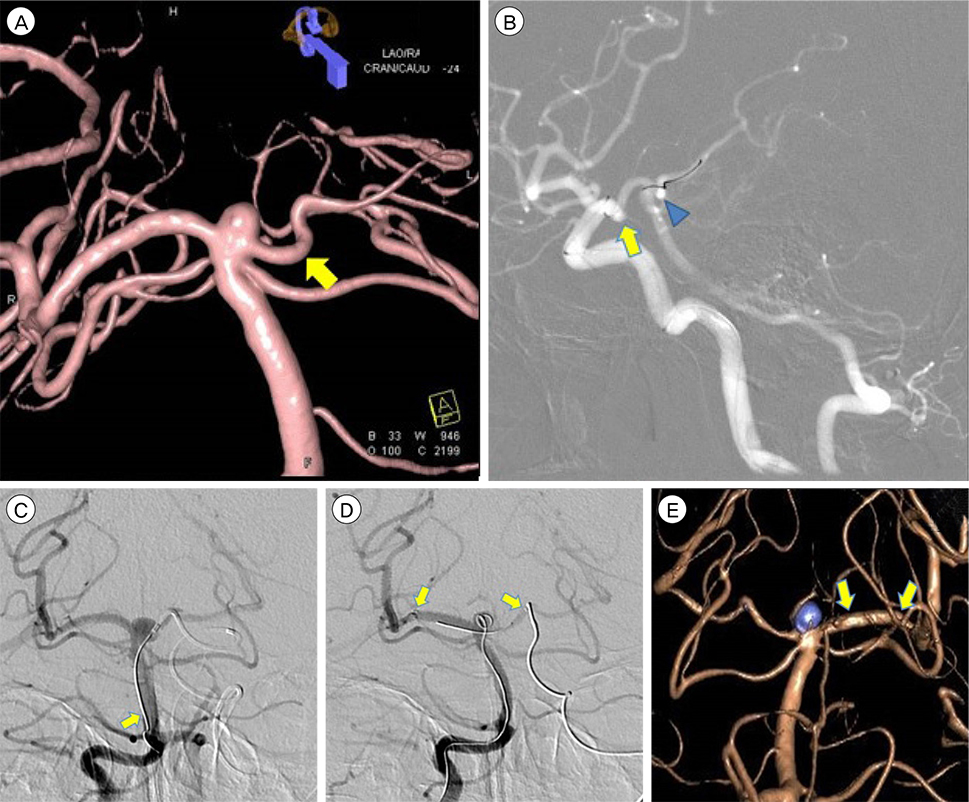J Cerebrovasc Endovasc Neurosurg.
2017 Sep;19(3):201-206. 10.7461/jcen.2017.19.3.201.
Horizontal Stent Assisted Coiling of Wide Neck Basilar Tip Aneurysm: Comparison of Two Cases
- Affiliations
-
- 1Department of Neurosurgery, Cheongju St. Mary's Hospital, The Catholic University of Korea, Cheongju, Korea.
- 2Department of Neurosurgery, St. Vincent's Hospital, The Catholic University of Korea, Suwon, Korea. jaehoonsung@gmail.com
- KMID: 2393503
- DOI: http://doi.org/10.7461/jcen.2017.19.3.201
Abstract
- Currently, endovascular coiling is a popular treatment for basilar tip aneurysms, which usually involve a wide neck. Serious complications can occur when the posterior cerebral artery (PCA) originating from a wide neck is not properly preserved. Accordingly, various adjunctive procedures using stents or a balloon have been introduced. Herein we report two cases of basilar tip aneurysms in which retrograde horizontal (from one PCA to the other PCA) stent-assisted coiling was successful, and we provide a summary of the important technical points.
Keyword
MeSH Terms
Figure
Cited by 1 articles
-
Endovascular Coiling for a Wide-neck Bifurcated Aneurysm with Anterograde Horizontal Stenting via Microcatheter Looping: A Technical Case Report
Hyun-Jae Jeon, Jong-Hwa Park, Jong-Young Lee, Hong-Jun Jeon, Seoung-Woo Park, Byung-Moon Cho
J Cerebrovasc Endovasc Neurosurg. 2018;20(3):181-186. doi: 10.7461/jcen.2018.20.3.181.
Reference
-
1. Akgul E, Aksungur E, Balli T, Onan B, Yilmaz DM, Bicakci S, et al. Y-stent-assisted coil embolization of wide-neck intracranial aneurysms. A single center experience. Interv Neuroradiol. 2011; 03. 17(1):36–48.2. Blackburn SL, Kadkhodayan Y, Shekhtman E, Derdeyn CP, Cross DT 3rd, Moran CJ. Treatment of basilar tip aneurysms with horizontal pca to pca stent-assisted coiling: Case series. J Neurointerv Surg. 2013; 05. 5(3):212–216.
Article3. Cross DT 3rd, Moran CJ, Derdeyn CP, Mazumdar A, Rivet D, Chicoine MM. Neuroform stent deployment for treatment of a basilar tip aneurysm via a posterior communicating artery route. AJNR Am J Neuroradiol. 2005; Nov-Dec. 26(10):2578–2581.4. Horowitz M, Levy E, Sauvageau E, Genevro J, Guterman LR, Hanel R, et al. Intra/extra-aneurysmal stent placement for management of complex and wide-necked-bifurcation aneurysms: Eight cases using the waffle cone technique. Neurosurgery. 2006; 04. 58:4 Suppl 2. ONS-258–ONS-262. discussion ONS-262.5. Liu W, Kung DK, Policeni B, Rossen JD, Jabbour PM, Hasan DM. Stent-assisted coil embolization of complex wide-necked bifurcation cerebral aneurysms using the “waffle cone” technique. A review of ten consecutive cases. Interv Neuroradiol. 2012; 03. 18(1):20–28.6. Moret J, Cognard C, Weill A, Castaings L, Rey A. The “remodelling technique” in the treatment of wide neck intracranial aneurysms. Angiographic results and clinical follow-up in 56 cases. Interv Neuroradiol. 1997; 03. 3(1):21–35.7. Xu X, Zheng Y, Wang D, Cui J, Shang X. Improved endovascular coiling of wide-neck intracranial aneurysms in elderly patients by double-microcatheter technique. Cell Biochem Biophys. 2015; 04. 71(3):1281–1286.8. Yashar P, Kan PT, Levy EI. Horizontal deployment of an intracranial stent via an antegrade approach for coil embolization of a basilar apex aneurysm: Technical note. J Neurointerv Surg. 2011; 12. 3(4):355–357.
Article
- Full Text Links
- Actions
-
Cited
- CITED
-
- Close
- Share
- Similar articles
-
- Very Late Stent Thrombosis after Sole Stent-Assisted Coiling at the Paraclinoid Giant Aneurysm : Could Prophylactic Antiplatelet Therapy Be Ceased at the Only 1 Year after Procedure?
- Staged Y-shaped Stent Assisted Coil Embolization in a Wide-Neck Basilar Tip Aneurysm: Case Report
- Kissing Aneurysms at Fenestrated Proximal Basilar Artery: Double-barrel Stent-assisted Coiling Using Dual Closed-cell Stents
- Waffle-Cone Technique Using Solitaire AB Stent
- Y-Stenting Endovascular Treatment for Ruptured Intracranial Aneurysms : A Single-Institution Experience in Korea



